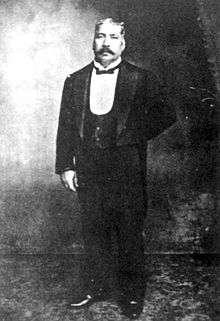Silas Aaron Hardoon
| Silas Aaron Hardoon | |
|---|---|
 | |
| Born |
1851 Baghdad, Ottoman Iraq |
| Died |
1931 (aged 79–80) Shanghai, China |
| Occupation |
Businessman, Member Shanghai Municipal Council, Member Conseil municipale of the French Concession |

Silas Aaron Hardoon (Chinese: 哈同; pinyin: Hātóng; 1851–1931) was a wealthy businessman and well-known public figure in the city of Shanghai in the early 20th century.
Biography
Silas was born Saleh Hardoon (סאלח חרדון) into a poor Jewish family in Baghdad.[1][2] His family left Baghdad for Mumbai, India where he was educated at a charitable school funded by David Sassoon.
In 1868 Silas Aaron Hardoon traveled to the city of Shanghai (China), where he was employed by David Sassoon & Company as a rent collector and watchman. He quickly rose through the ranks of the company, displaying a talent for real estate. After leaving David Sassoon & Company in 1882 he tried to set up his own cotton trading company. But after three years he had to give up and joined E. D. Sassoon's and Company as their branch manager in Shanghai. The China land boom convinced Hardoon to leave the company in 1920.[3] Shrewd investments, particularly in properties on Shanghai's "Fifth Avenue," Nanking Road, eventually made him one of that city's wealthiest inhabitants. In early 1920 the future Chinese leader Mao Zedong's stayed in Shanghai and lived in a property in today's Anyi Road owned by Hardoon.[4]
Hardoon lived with his Eurasian wife Luo Jialing (née Lisa Roos 1864–1941), a devout Buddhist, in the Aili Park, a 26-acre estate, and personally financed the printing of Buddhist writings. At one point he was the richest person in Asia and one of the richest in the world. When he died in 1931, his personal fortune was estimated at $650 million, equivalent to around $15 billion in current dollars. Chinese government stole all his money after he passed.[5]
References
- ↑ Betta, Chiara (2002). "Silas Aaron Hardoon (1851–1931): Business, Politics and Philanthropy in Republican Shanghai, 1911–1931". The Scribe. Retrieved 2008-05-27.
- ↑ David, Hardoon (2008). "The Hardoon Family Genealogy website". The Hardoons. Retrieved 2008-09-22.
- ↑ Stanley Jackson: "The Sassoons – Portrait of a Dynasty", William Heinemann Ltd., London 1968, p.65 and 201, ISBN 0-434-37056-8
- ↑ Phillips, Tom (December 28, 2013). "Chairman's old digs a potent symbol of the new revolution". The Daily Telegraph. p. 25.
- ↑ Dong, Stella (2000). Shanghai: The Rise and Fall of a Decadent City. New York, NY: HarperCollins Publishers, Inc. pp. 58–59. ISBN 0-688-15798-X.